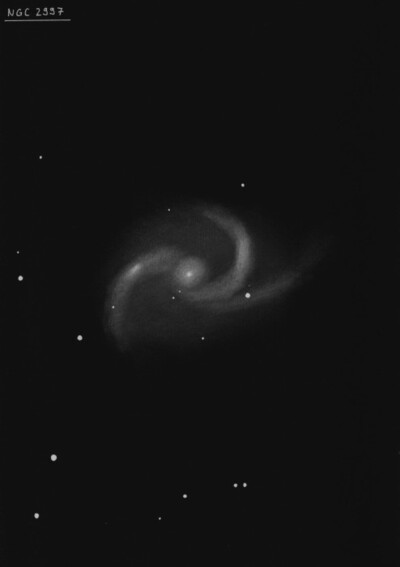
William Herschel discovered NGC 2997 = H V-50 = h3188 on 4 Mar 1793 (sweep 1033) and recorded "vF, vS, lbM, lE about 8' long and 5 or 6' broad, a little from sp to nf about 10 or 15°." This galaxy is the 4th most southerly object he discovered.
James Dunlop observed the galaxy on 7 May 1826 and recorded D 622 as "a faint elliptical nebula, 2.5' long and 1.5' broad, with a small star involved in the western margin. His position is 15' too far NE, but the star involved on the southwest side seems to confirm the equivalence.
John Herschel made two detailed observations (h3188): on 28 Jan 1835 he logged "pB, vL, R, very suddenly a little brighter in the middle, to a pretty distinct round nucleus 4" in diameter. Diameter of nebula = 15 sec of time. The nebulous atmosphere extremely dilute. A very remarkable object." On a later sweep he recorded "F, vL, first very gradually then very suddenly much brighter in the middle, to a nucleus (exactly like Halley's comet) as now (Feb. 16, 1836) seen in the equatorial; round; diam. in RA = 24 seconds. Has a 11th mag star S.p. just at the edge."
300/350mm - 13.1" (1/18/85): fairly bright, very large, elongated 3:2 ~E-W, 4.5'x3.0', sharply concentrated with a bright core, no nucleus. A mag 13 star is at the SW edge of the halo 2.0' from center.
600/800mm - 24" (4/10/08 - Magellan Observatory, Australia): at 215x, this beautiful, asymmetric face-on spiral extended ~7'x4.5' and was sharply concentrated with a very bright 40" core. The spiral structure is unusual with a very long, relatively thick arm that curves from west to east on the north side of the core. This arm then bends south on the east side and contains a very faint 20" HII knot situated northeast of the core [1.6' from center] and symmetrically placed opposite a mag 12 star in the outer halo on the southwest side. This HII region is identified in NED as NGC 2997:[MM 81] 306, from the 1981 paper "Morphology and Kinematics of the Ionized Gas in NGC 2997" by Milliard and Marcelin in A&A, 95, 59. A mag 14.5 star is near the end of this arm and due east of the core. To the west of the end of this arm the light level noticeably dips (this is a gap between the arms) as well as on the southeast side of the halo, giving an asymmetric appearance.
A second fainter outer arm running roughly SW to NE also wraps around the galaxy on the west and north side but at further distance from the core. This outer arm nearly reaches a mag 12 star on the southwest side (the one opposite the knot mentioned above) and then can be followed with more difficulty to the east where it attaches on the south side of the core.
900/1200mm - 48" (4/22/17): Gorgeous grand-design spiral at 375x! Appeared very bright and large, with the arms stretching roughly 7' E-W. The galaxy is sharply concentrated with a round, intensely bright nucleus ~30" diameter. The spiral arms were sharply etched by intra-arm dust and appeared similar to a photograph of the galaxy. One thick arm is attached to the core on the west or southwest side. It curls counterclockwise on the north side towards the east (fairly flat curvature) and includes a slightly bright patch on the northeast portion [1.6' from center]. This arm continues and bends south, passing just inside a mag 14.5 star [2.5' E of center], and then quickly fading out to the south of this star. The second prominent arm is attached to the core on its northeast side. It curls counterclockwise to the east on the south and contains a brighter knotty section (numerous HII regions are embedded) nearly 1' in length that's just inside a mag 12 star 2.2' SW of center. This arm turns abruptly to the north as it curls around the west side and ends on the northwest side of the halo.
Notes by Steve Gottlieb